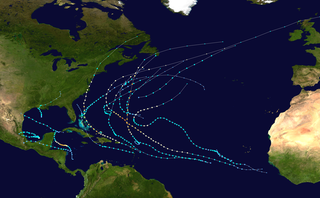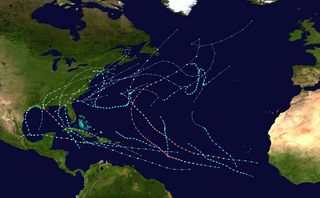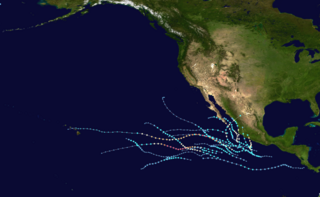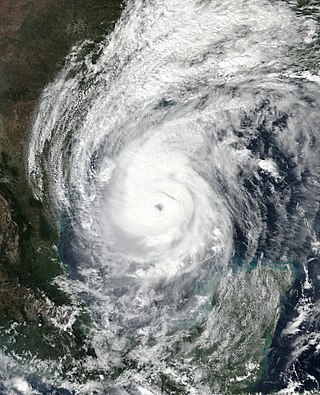
The 2011 Pacific hurricane season was a below average season in terms of named storms,although it had an above average number of hurricanes and major hurricanes. During the season,13 tropical depressions formed along with 11 tropical storms,10 hurricanes and 6 major hurricanes. The season officially began on May 15 in the East Pacific Ocean,and on June 1 in the Central Pacific;they both ended on November 30. These dates conventionally delimit the period of each year when most tropical cyclones form in the Pacific basin. The season's first cyclone,Hurricane Adrian formed on June 7,and the last,Hurricane Kenneth,dissipated on November 25.

The 2008 Atlantic hurricane season was an event in the annual tropical cyclone season in the north Atlantic Ocean. An above-average Atlantic hurricane season,it was the first on record to have a major hurricane in every month from July to November.

The 2011 Atlantic hurricane season was an event in the annual hurricane season in the north Atlantic Ocean. It was well above average,with 19 tropical storms forming. Even so,it was the first season on record in which the first eight storms failed to attain hurricane strength. The season officially began on June 1,2011,and ended on November 30,2011,dates that conventionally delimit the period of each year when most tropical cyclones develop in the Atlantic basin. The season's first storm,Tropical Storm Arlene did not form until June 28. The final storm to develop,Tropical Storm Sean,dissipated on November 11.

The 2020 Atlantic hurricane season is the most active Atlantic hurricane season on record,in terms of number of systems. It featured a total of 31 tropical or subtropical cyclones,with all but one cyclone becoming a named storm. Of the 30 named storms,14 developed into hurricanes,and a record-tying seven further intensified into major hurricanes. It was the second and final season to use the Greek letter storm naming system,the first being 2005,the previous record. Of the 30 named storms,11 of them made landfall in the contiguous United States,breaking the record of nine set in 1916. During the season,27 tropical storms established a new record for earliest formation date by storm number. This season also featured a record ten tropical cyclones that underwent rapid intensification,tying it with 1995,as well as tying the record for most Category 4 hurricanes in a singular season in the Atlantic Basin. This unprecedented activity was fueled by a La Niña that developed in the summer months of 2020,continuing a stretch of above-average seasonal activity that began in 2016. Despite the record-high activity,this was the first season since 2015 in which no Category 5 hurricanes formed.

Hurricane Harvey was the costliest tropical cyclone on record,inflicting roughly $125 billion in damage across the Houston metropolitan area and Southeast Texas. It lasted from mid-August until early September 2017,with many records for rainfall and landfall intensity set during that time. The eighth named storm,third hurricane,and first major hurricane of the 2017 Atlantic hurricane season,Harvey originated from a broad area of low pressure southwest of Cape Verde that was first monitored on August 13. Tracking steadily westward,the disturbance developed strong convection,a well-defined circulation,and sustained tropical storm-force winds,leading to the classification of Tropical Storm Harvey late on August 17. Moderate easterly vertical wind shear kept Harvey weak,as it continued westwards into the Caribbean Sea;despite repeated predictions for gradual intensification by the National Hurricane Center,Harvey eventually opened up into a tropical wave on August 19. The remnants of Harvey continued to move westwards and reached the Yucatán Peninsula on August 22,and were forecast to regenerate into a tropical cyclone after exiting land.

Hurricane Irma was an extremely powerful Cape Verde hurricane that caused extensive damage in the Caribbean and Florida. Lasting from late August to mid-September 2017,the storm was the strongest open-Atlantic tropical cyclone on record and the first Category 5 hurricane to strike the Leeward Islands. Classified as the ninth named storm,fourth hurricane,and second major hurricane of the hyperactive 2017 Atlantic hurricane season,Irma developed from a tropical wave near the Cape Verde Islands on August 30. Favorable conditions allowed the cyclone to become a hurricane on the following day and then rapidly intensify into a major hurricane by September 1 as it moved generally westward across the Atlantic. However,dry air and eyewall replacement cycles disrupted further strengthening,with fluctuations in intensity during the next few days. Irma resumed deepening upon encountering warmer sea surface temperatures,while approaching the Lesser Antilles on September 4. The system reached Category 5 intensity on the following day and peaked with winds of 180 mph (290 km/h) shortly thereafter.

Hurricane Maria was among the most intense Atlantic hurricanes on record and caused catastrophic damage in Puerto Rico in late September 2017. Originating from a tropical wave,it developed into a tropical depression on September 16 while situated to the east of the Lesser Antilles. Gradual intensification occurred over the next day or two and it strengthened into a tropical storm,which was named Maria. By late on September 17,Maria had intensified into a hurricane. As it approached the island arc,it underwent explosive intensification on September 18,with the hurricane reaching Category 5 intensity as it made landfall on the island of Dominica early on September 19. Land interaction weakened the storm somewhat,although it was able to quickly recover and later peaked that night with sustained winds of 175 mph (280 km/h) and a pressure of 908 mbar (26.8 inHg). Early the next morning it weakened to a high-end Category 4 hurricane before making landfall in Puerto Rico. Maria weakened significantly due to crossing the island,but was able to strengthen somewhat as it passed close to Hispaniola and The Bahamas on September 21–23. Structural changes in the hurricane as it moved further north and close to the Outer Banks in the United States ultimately caused Maria to weaken quickly. Turning away from the United States as a weakened tropical storm,it became extratropical on September 30,dissipating 3 days later.

The 2021 Atlantic hurricane season was the third-most active Atlantic hurricane season on record in terms of number of tropical cyclones,although many of them were weak and short-lived. With 21 named storms forming,it became the second season in a row and third overall in which the designated 21-name list of storm names was exhausted. Seven of those storms strengthened into a hurricane,four of which reached major hurricane intensity,which is slightly above-average. The season officially began on June 1 and ended on November 30. These dates historically describe the period in each year when most Atlantic tropical cyclones form. However,subtropical or tropical cyclogenesis is possible at any time of the year,as demonstrated by the development of Tropical Storm Ana on May 22,making this the seventh consecutive year in which a storm developed outside of the official season.

The 2021 Pacific hurricane season was a moderately active Pacific hurricane season,with above-average activity in terms of number of named storms,but below-average activity in terms of major hurricanes,as 19 named storms,8 hurricanes,and 2 major hurricanes formed in all. It also had a near-normal accumulated cyclone energy (ACE). The season officially began on May 15,2021 in the Eastern Pacific Ocean,and on June 1,2021,in the Central Pacific in the Northern Hemisphere. The season ended in both regions on November 30,2021. These dates historically describe the period each year when most tropical cyclogenesis occurs in these regions of the Pacific and are adopted by convention. However,the formation of tropical cyclones is possible at any time of the year,as illustrated by the formation of Tropical Storm Andres on May 9,which was the earliest forming tropical storm on record in the Eastern Pacific. Conversely,2021 was the second consecutive season in which no tropical cyclones formed in the Central Pacific.

Hurricane Genevieve was a strong tropical cyclone that almost made landfall on the Baja California Peninsula in August 2020. Genevieve was the twelfth tropical cyclone,eighth named storm,third hurricane,and second major hurricane of the 2020 Pacific hurricane season. The cyclone formed from a tropical wave that the National Hurricane Center (NHC) first started monitoring on August 10. The wave merged with a trough of low pressure on August 13,and favorable conditions allowed the wave to intensify into Tropical Depression Twelve-E at 15:00 UTC. Just six hours later,the depression became a tropical storm and was given the name Genevieve. Genevieve quickly became a hurricane by August 17,and Genevieve began explosive intensification the next day. By 12:00 UTC on August 18,Genevieve reached its peak intensity as a Category 4 hurricane,with maximum 1-minute sustained winds of 130 mph and a minimum central pressure of 950 millibars (28 inHg). Genevieve began to weaken on the next day,possibly due to cooler waters caused by Hurricane Elida earlier that month. Genevieve weakened below tropical storm status around 18:00 UTC on August 20,as it passed close to Baja California Sur. Soon afterward,Genevieve began to lose its deep convection and became a post-tropical cyclone by 21:00 UTC on August 21,eventually dissipating off the coast of Southern California late on August 24.

Hurricane Marco was the first of two tropical cyclones to threaten the Gulf Coast of the United States within a three-day period. The thirteenth named storm and third hurricane of the record-breaking 2020 Atlantic hurricane season,Marco developed from a fast-moving tropical wave west of the Windward Islands and south of Jamaica on August 20. The fast motion of the wave inhibited intensification initially,but as the wave slowed down and entered a more favorable environment,the system developed into a tropical depression,which in turn rapidly intensified into a strong tropical storm. Due to strong wind shear,Marco's intensification temporarily halted. However,after entering the warm waters of the Gulf of Mexico on August 23,Marco briefly intensified into a hurricane,only to quickly weaken later that evening due to another rapid increase in wind shear. Marco subsequently weakened to a tropical depression before degenerating into a remnant low early the next morning. Marco's remnants subsequently dissipated on August 26.

Hurricane Sally was a destructive and slow-moving Atlantic hurricane that was the first hurricane to make landfall in the U.S. state of Alabama since Ivan in 2004,coincidentally on the same date in the same place. The eighteenth named storm and seventh hurricane of the extremely active 2020 Atlantic hurricane season,Sally developed from an area of disturbed weather which was first monitored over the Bahamas on September 10. The system grew a broad area of low-pressure on September 11,and was designated as a tropical depression late that day. Early the next day,the depression made landfall at Key Biscayne and subsequently strengthened into Tropical Storm Sally that afternoon. Moderate northwesterly shear prevented significant intensification for the first two days,but convection continued to grow towards the center and Sally slowly intensified. On September 14,a center reformation into the center of the convection occurred,and data from a hurricane hunter reconnaissance aircraft showed that Sally had rapidly intensified into a strong Category 1 hurricane. However,an increase in wind shear and upwelling of colder waters halted the intensification and Sally weakened slightly on September 15 before turning slowly northeastward. Despite this increase in wind shear,it unexpectedly re-intensified,reaching Category 2 status early on September 16 before making landfall at peak intensity at 09:45 UTC on September 16,near Gulf Shores,Alabama,with maximum sustained winds of 110 mph (180 km/h) and a minimum central pressure of 965 millibars (28.5 inHg). The storm rapidly weakened after landfall before transitioning into an extratropical low at 12:00 UTC the next day. Sally's remnants lasted for another day as they moved off the coast of the Southeastern United States before being absorbed into another extratropical storm on September 18.

Hurricane Paulette was a strong and long-lived Category 2 Atlantic hurricane which became the first to make landfall in Bermuda since Hurricane Gonzalo in 2014,and was the longest-lasting tropical cyclone of 2020 globally. The sixteenth named storm and sixth hurricane of the record-breaking 2020 Atlantic hurricane season,Paulette developed from a tropical wave that left the coast of Africa on September 2. The wave eventually consolidated into a tropical depression on September 7. Paulette fluctuated in intensity over the next few days,due to strong wind shear,initially peaking as a strong tropical storm on September 8. It eventually strengthened into a hurricane early on September 13 as shear decreased. On September 14,Paulette made landfall in northeastern Bermuda as a Category 2 hurricane,while making a gradual turn to the northeast. The cyclone further strengthened as it moved away from the island,reaching its peak intensity with 1-minute sustained winds of 105 mph (169 km/h) and a minimum central atmospheric pressure of 965 mbar (28.5 inHg) on September 14. On the evening of September 15,Paulette began to weaken and undergo extratropical transition,which it completed on September 16. The hurricane's extratropical remnants persisted and moved southward then eastward,and eventually,Paulette regenerated into a tropical storm early on September 20 south of the Azores–which resulted in the U.S National Weather Service coining the phrase "zombie storm" to describe its unusual regeneration. Paulette's second phase proved short-lived,however,as the storm quickly weakened and became post-tropical again two days later. The remnant persisted for several days before dissipating south of the Azores on September 28. In total,Paulette was a tropical cyclone for 11.25 days,and the system had an overall lifespan of 21 days.

Tropical Storm Beta was a tropical cyclone that brought heavy rainfall,flooding,and severe weather to the Southeastern United States in September 2020. The twenty-third tropical depression and twenty-third named storm of the record-breaking 2020 Atlantic hurricane season,Beta originally formed from a trough of low pressure that developed in the northeastern Gulf of Mexico on September 10. The low moved slowly southwestward,with development hampered initially by the development of nearby Hurricane Sally. After Sally moved inland over the Southeastern United States and weakened,the disturbance became nearly stationary in the southwestern Gulf,where it began to organize. By September 16,the storm had gained a low-level circulation center and had enough organization to be designated as Tropical Depression Twenty-Two. The system held its intensity for a day due to the influence of strong wind shear and dry air,before eventually attaining tropical storm strength. It slowly moved northward and intensified to a mid-range tropical storm before dry air and wind shear halted its intensification. Beta then became nearly stationary on September 19,before starting to move west towards the Texas coast the next day,weakening as it approached. On September 21,Beta made landfall near Matagorda Peninsula,Texas as a minimal tropical storm. It subsequently weakened to a tropical depression the next day before becoming post-tropical early on September 23. Its remnants moved northeastward,before the center elongated and merged with a cold front early on September 25.

Hurricane Gamma was a Category 1 hurricane that brought heavy rains,flooding,and landslides to the Yucatán Peninsula in early October 2020. The twenty-fifth depression,twenty-fourth named storm and ninth hurricane of the extremely active 2020 Atlantic hurricane season,Gamma developed from a vigorous tropical wave that had been monitored as it was entering the Eastern Caribbean on September 29. The wave moved westward and slowed down as it moved into the Western Caribbean,where it began to interact with a dissipating cold front. A low formed within the disturbance on October 1 and the next day,it organized into a tropical depression. It further organized into Tropical Storm Gamma early the next day. It continued to intensify and made landfall as a minimal hurricane near Tulum,Mexico,on October 3. It weakened over land before reemerging in the Gulf of Mexico. Gamma then briefly restrengthened some before being blasted by high amounts of wind shear,causing it to weaken again. It made a second landfall as a tropical depression in Nichili,Mexico on October 6 before dissipating as it was absorbed by the approaching Hurricane Delta.

Hurricane Delta was the record-tying fourth named storm of 2020 to make landfall in Louisiana,as well as the record-breaking tenth named storm to strike the United States in that year. The twenty-sixth tropical cyclone,twenty-fifth named storm,tenth hurricane,and third major hurricane of the record-breaking 2020 Atlantic hurricane season,Delta formed from a tropical wave which was first monitored by the National Hurricane Center (NHC) on October 1. Moving westward,the tropical wave began to quickly organize. A well-defined center of circulation formed with sufficiently organized deep convection on October 4,and was designated as Tropical Depression Twenty-six and soon thereafter,Tropical Storm Delta. Extremely rapid intensification ensued throughout October 5 into October 6,with Delta becoming a Category 4 hurricane within 28 hours of attaining tropical storm status. The rate of intensification was the fastest in the Atlantic basin since Hurricane Wilma in 2005. After peaking in intensity however,an unexpected increase in wind shear and dry air quickly weakened the small storm before it made landfall in Puerto Morelos,Mexico as a Category 2 hurricane with 105 mph (169 km/h) winds. It weakened some more over land before emerging into the Gulf of Mexico,where it was downgraded to a Category 1 hurricane. After that,it began to restrengthen,regaining Category 3 status late on October 8. It then turned northward and reached a secondary peak intensity of 953 mbar (28.14 inHg) and winds of 120 mph early on October 9. Delta then began to turn more north-northeastward into an area of cooler waters,higher wind shear,and dry air,causing it to weaken back to Category 2 status. Delta then made landfall at 23:00 UTC near Creole,Louisiana with winds of 100 mph (160 km/h) and a pressure of 970 mbar (29 inHg). The storm began to weaken more rapidly after landfall,becoming post-tropical just 22 hours later.

The 2021 Pacific hurricane season was a moderately active hurricane season,with above-average tropical activity in terms of named storms,but featured below-average activity in terms of major hurricanes. It is the first season to have at least five systems make landfall in Mexico,the most since 2018. It was also the second consecutive season in which no tropical cyclones formed in the Central Pacific. The season officially began on May 15 in the Eastern Pacific,and on June 1 in the Central Pacific;both ended on November 30. These dates historically describe the period each year when most tropical cyclones form in the eastern and central Pacific and are adopted by convention. However,the formation of tropical cyclones is possible at any time of the year,as illustrated this year by the formation of Tropical Storm Andres on May 9. This was the earliest forming tropical storm on record in the Eastern Pacific. The season effectively ended with the dissipation of Tropical Storm Terry,on November 10.

Tropical Storm Danny was a weak and short-lived tropical cyclone that caused minor damage to the U.S. states of South Carolina and Georgia. The fourth named storm of the 2021 Atlantic hurricane season,the system formed from an area of low-pressure that developed from an upper-level trough over the central Atlantic Ocean on June 22. Moving west-northwestward,the disturbance gradually developed as convection,or showers and thunderstorms,increased over it. Although it was moving over the warm Gulf Stream,the organization of the disturbance was hindered by strong upper-level wind shear. By 18:00 UTC of June 27,as satellite images showed a well-defined center and thunderstorms,the system was upgraded to a tropical depression by the National Hurricane Center (NHC). At 06:00 UTC on the next day,the system further strengthened into Tropical Storm Danny east-southeast of Charleston,South Carolina. Danny continued its track towards South Carolina while slowly strengthening,subsequently reaching its peak intensity at that day of 45 mph (72 km/h) and a minimum central pressure of 1,009 mbar (29.8 inHg) at 18:00 UTC. Danny then made landfall in Pritchards Island,north of Hilton Head,in a slightly weakened state at 23:20 UTC on the same day,with winds of 40 mph (64 km/h) and indicating that Danny weakened prior to moving inland. The system then weakened to a tropical depression over east-central Georgia,before dissipating shortly afterward.

Hurricane Grace was the strongest tropical cyclone to make landfall in the Mexican state of Veracruz. Grace impacted much of the Leeward Islands and Greater Antilles as a tropical storm,before causing more substantial impacts in the Yucatán Peninsula and Veracruz as a hurricane. It was the seventh named storm,second hurricane,and first major hurricane of the 2021 Atlantic hurricane season. Originating from a tropical wave in the Main Development Region,the primitive system tracked west-northwest across the Atlantic Ocean towards the Antilles,becoming a tropical depression on August 14. It strengthened into Tropical Storm Grace later the same day,but weakened back to a depression due to an unfavorable environment. After moving near Haiti as a tropical depression,it strengthened back to a tropical storm and became a hurricane on August 18,reaching an initial peak intensity with maximum sustained winds of 80 mph (130 km/h) and a pressure of 986 mbar (29.12 inHg). It weakened back to a tropical storm after its landfall in the Yucatán Peninsula and emerged into the Bay of Campeche,entering a very favorable environment for intensification hours later. Grace then rapidly intensified into a Category 3 hurricane with winds of 120 mph (190 km/h) in about 24 hours. The storm made its final landfall in the state of Veracruz at peak intensity and quickly degenerated into a remnant low over mainland Mexico on August 21;however,its remnants later regenerated into Tropical Storm Marty in the Eastern Pacific on August 23.

Hurricane Nicholas was a slow-moving and erratic Category 1 hurricane that made landfall in the U.S. state of Texas in mid-September 2021. The fourteenth named storm and sixth hurricane of the 2021 Atlantic hurricane season,Nicholas originated from a tropical wave that emerged off the west coast of Africa on August 28. The system developed into a tropical storm on September 12,with the National Hurricane Center (NHC) naming the cyclone Nicholas. Nicholas gradually intensified initially,due to adverse effects of strong wind shear. However,late on September 13,Nicholas began intensifying at a faster rate,and at 03:00 UTC on September 14,Nicholas intensified into a Category 1 hurricane,with maximum sustained winds of 75 mph (121 km/h) and a minimum central pressure of 988 mbar (29.2 inHg). At 5:30 UTC on the same day,Nicholas made landfall in Texas at peak intensity. Afterward,the system gradually weakened,weakening into a tropical storm several hours later,and weakening further into a tropical depression on the next day. The system proceeded to drift slowly over Louisiana. On September 15,Nicholas degenerated into a remnant low,before being absorbed into another extratropical system on September 20.



























